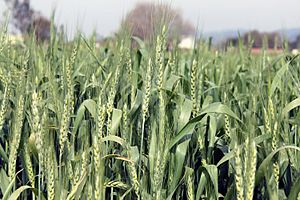Rabi crops facts for kids
Rabi crops are special plants that farmers grow during the winter season in places like South Asia. They are ready to be picked, or harvested, in the spring. The word "Rabi" actually comes from the Arabic language and means "spring."
What are Rabi Crops?
Rabi crops are also known as "winter crops" or "spring harvest." Farmers usually plant these crops around the middle of November. This is after the big monsoon rains have finished. The crops are then harvested in April or May. These plants get their water either from rain that has soaked deep into the ground or from irrigation systems. Sometimes, too much rain in winter can be bad for rabi crops, but it's often good for other types of crops called kharif crops.
In India, some common rabi crops include wheat, barley, mustard, sesame, and peas. Peas are often harvested earlier than other rabi crops because they grow quickly. You can find lots of fresh green peas in Indian markets from January to March, with the most available in February.
Types of Rabi Crops
Here are some examples of different kinds of rabi crops:
Cereals
These are grains that people eat:
Seed Plants
These plants are grown for their seeds, which can be used for oil, spices, or animal feed:
Vegetables
These are vegetables that grow well in the winter:
Images for kids





